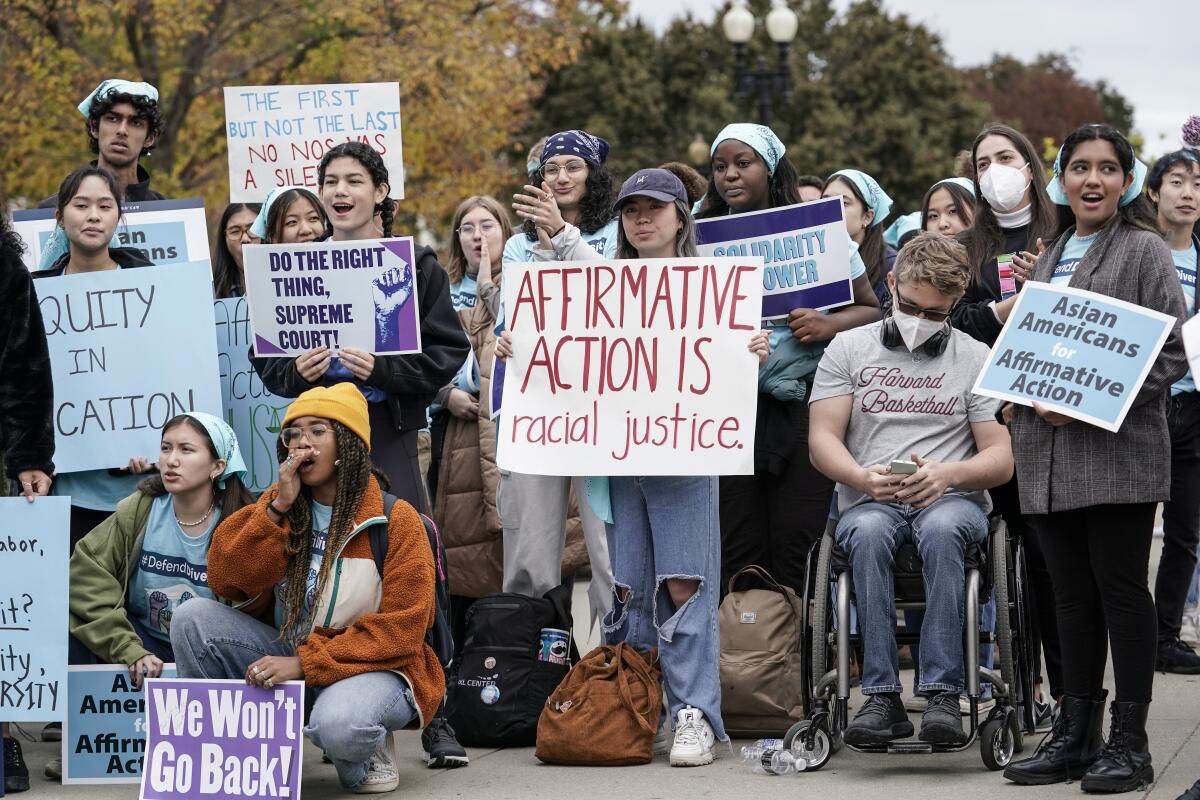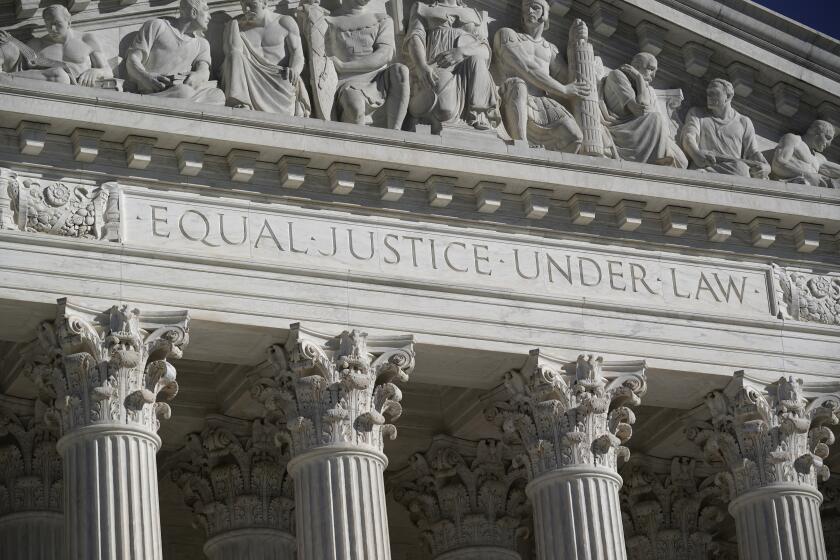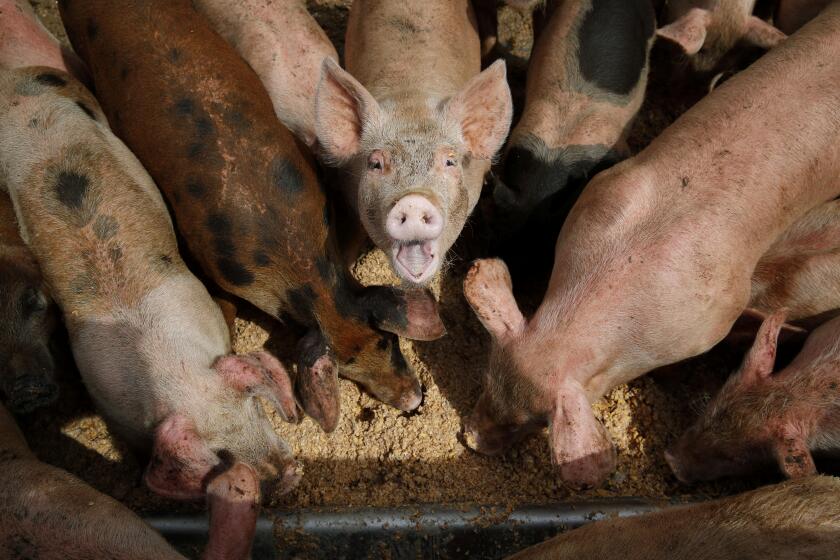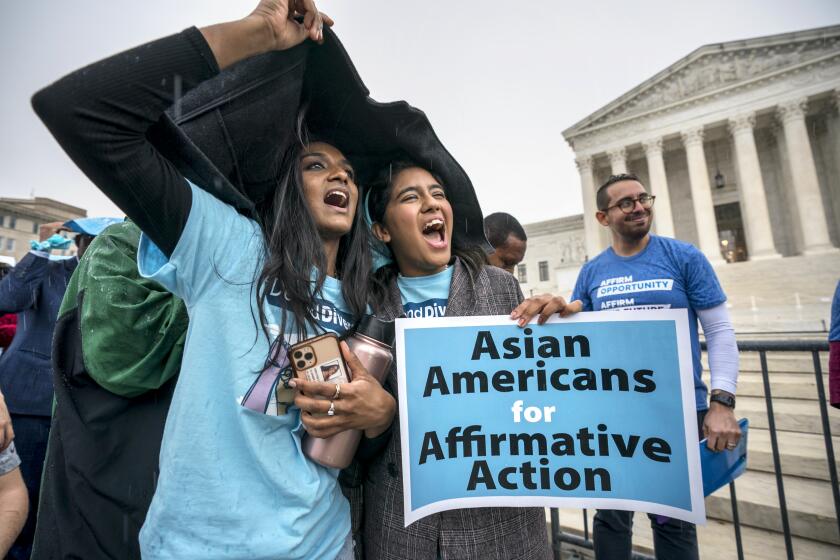Opinion: The Supreme Court’s ultimate ‘judicial activism’: striking down affirmative action in college admissions

For decades, conservatives have railed against judicial activism, but Thursday’s decision striking down affirmative action by colleges and universities in admissions was the height of conservative judicial activism. The court rejected almost half a century of precedents, overturned decisions made by public and private universities across the country, and ignored the history of the 14th Amendment of the Constitution.
The experience of California — where affirmative action was eliminated by Proposition 209 in 1996 — shows that it still will be possible to have diversity in higher education, but it will take sustained effort and it will be difficult.
In 1978, in University of California vs. Bakke, Justice Lewis Powell wrote the pivotal opinion and explained that colleges and universities have a compelling interest in having a diverse student body and may use race as one of many factors in admissions decisions to benefit minorities and enhance diversity. The Supreme Court reaffirmed this in 2003 in Grutter vs. Bollinger and again, most recently, in 2016, in Fisher vs. University of Texas, Austin. For decades, universities across the country have based their admissions policies on these holdings.
The decision in Allen vs. Milligan is most significant for what the court didn’t do: It did not further weaken the law of voting rights as many expected.
What changed in a mere seven years? Donald Trump appointed three justices: Neil Gorsuch, Brett Kavanaugh and Amy Coney Barrett. They joined the three conservative dissenters in the Fisher case — John G. Roberts Jr., Clarence Thomas and Samuel Alito — to overturn 45 years of precedents allowing affirmative action. As they did last year in overruling Roe vs. Wade, the conservatives on the court paid no attention to the principle of stare decisis and following precedent.
Nor did the conservatives on the court pay attention to the judgment of university educators that diversity in the classroom matters in education. I have been a law professor for 43 years and have taught classes that are overwhelmingly white and those with a significant number of minority students. The discussions in the classrooms are vastly different and the educational experience for all students is enhanced when there is diversity.
As Justice Sandra Day O’Connor explained in the Grutter decision, preparing students for our diverse society requires that they experience diversity. But the six conservative justices have now substituted their views and flatly rejected decades of experience of those in higher education.
And nor did the conservative justices who profess to be originalists, and are committed to following the original meaning of the Constitution, pay attention to the history of the 14th Amendment. The Congress that ratified it in 1868 also adopted race conscious programs, like the Freedman’s Bureau that today undoubtedly would be considered affirmative action.
The justices rejected the argument that the ‘dormant commerce clause’ principle prohibits Proposition 12 from affecting how Iowa farmers raise their pigs.
Justice Sonia Sotomayor, in a powerful dissent, cuts straight to the status of race in this country and explains why the Supreme Court itself has affirmed over and over again that affirmative action is constitutional. She wrote: “The Court cements a superficial rule of colorblindness as a constitutional principle in an endemically segregated society where race has always mattered and continues to matter. The Court subverts the constitutional guarantee of equal protection by further entrenching racial inequality in education, the very foundation of our democratic government and pluralistic society.”
The court’s decision on Thursday will have an enormous impact because it applies to all colleges and universities, public and private. There were two cases, one against a public university, University of North Carolina, and one against Harvard College, a private institution. The majority opinion, written by Chief Justice Roberts, said that the equal protection clause of the 14th Amendment outlaws affirmative action for public universities and that Title VI of the Civil Rights Act of 1964, which prohibits recipients of federal funds from discriminating based on race, prohibits it in private colleges.
The experience in California shows what could happen at universities all over this country. Proposition 209 had an immediate and devastating effect on diversity in the University of California. The number of Black and Latino first-year students fell by 50% in the years immediately after the ballot measure was passed. It took UCLA 19 years, until 2015, to reach its pre-Proposition 209 levels of diversity.
But the UC system — and state institutions in states like Michigan and Washington that also abolished affirmative action — have found ways to achieve diversity through concerted efforts. There still can be aggressive outreach and recruitment of students to form a diverse campus community.
If they truly want a diverse student body, colleges and universities must eliminate all other preferential admissions policies, especially for legacy applicants.
Also, Roberts explicitly wrote, “Nothing in this opinion should be construed as prohibiting universities from considering an applicant’s discussion of how race affected his or her life, be it through discrimination, inspiration, or otherwise.”
This appears to allow admissions decisions to examine the diversity of experience, which includes the importance of race, in the applicant’s life. And as Sotomayor wrote, universities may consider other factors — like socioeconomic status — that may yield diversity. But the court left unclear whether any factors used in admissions decisions to achieve diversity are constitutional if they are done with the purpose and effect of increasing access for minority applicants.
The immediate impact of Thursday’s decision cannot be overstated. At least in the short term, there will be a dramatic change in admissions decisions and students of color will be harmed. It is crucial to remember that this decision is not about following legal principles as they have stood and been tested over and over for a generation. It is entirely about the ideology of six conservatives on the court again moving the law far to the right.
Erwin Chemerinsky is a contributing writer to Opinion and the dean of the UC Berkeley School of Law. His latest book is “Worse Than Nothing: The Dangerous Fallacy of Originalism.”
More to Read
A cure for the common opinion
Get thought-provoking perspectives with our weekly newsletter.
You may occasionally receive promotional content from the Los Angeles Times.













